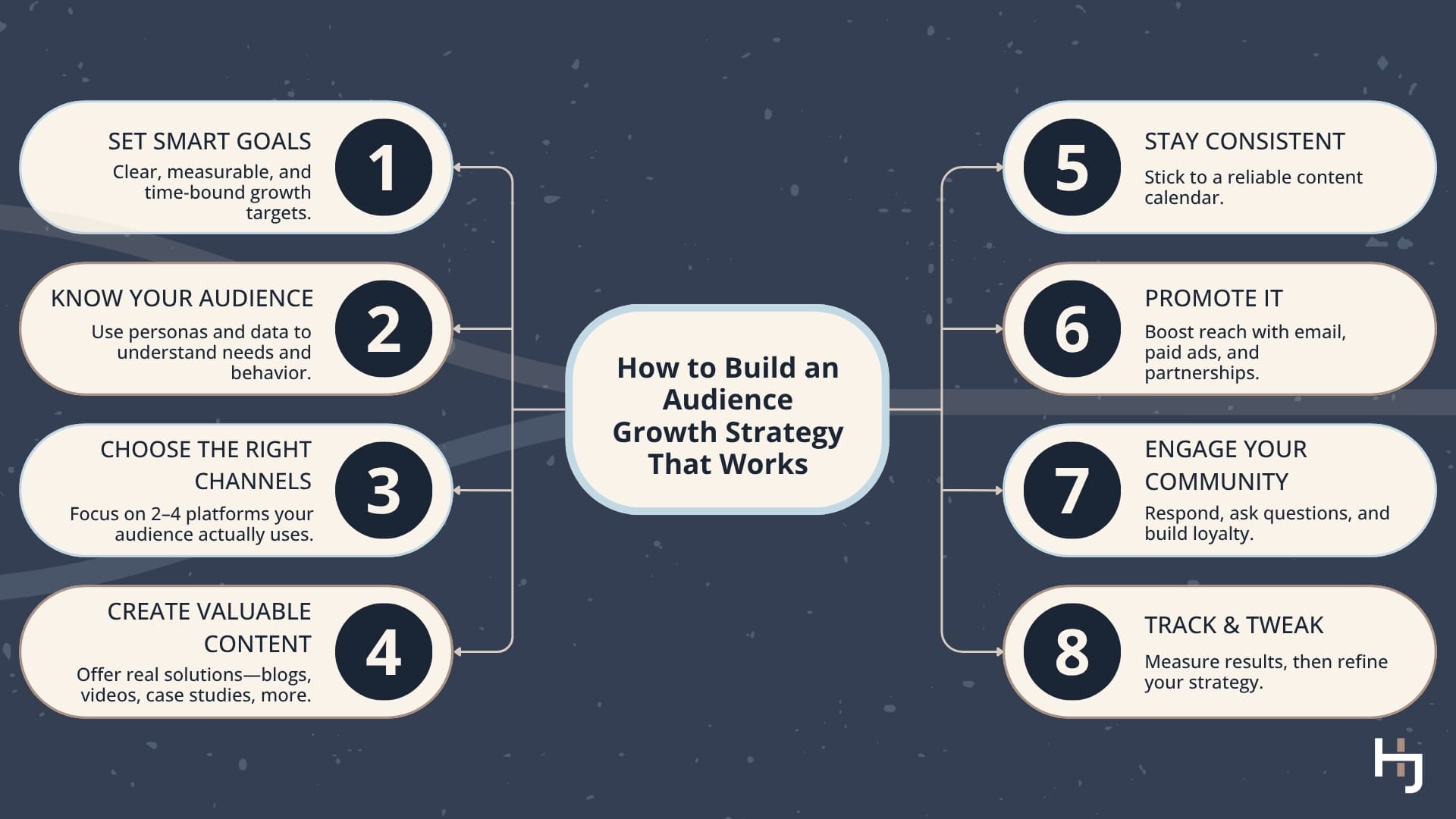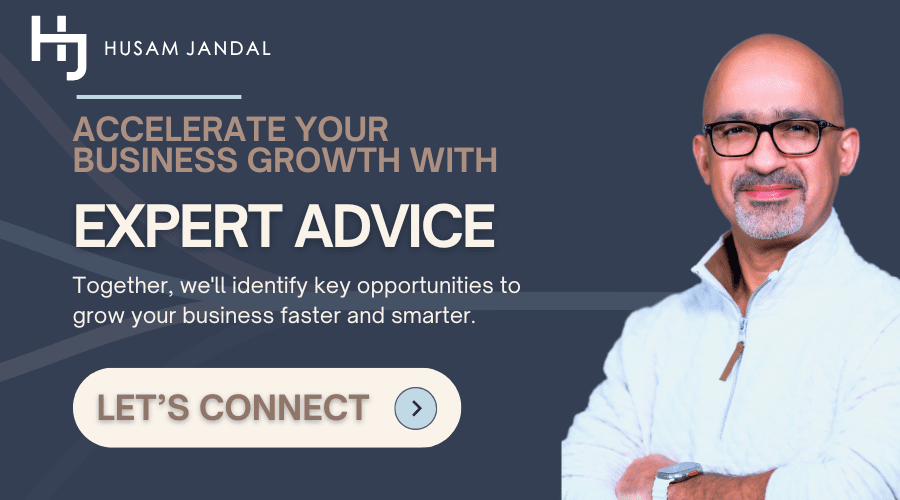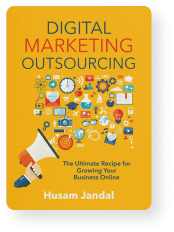 You’re constantly publishing. You’re showing up in search. You’re investing in paid campaigns. But when results slow down the moment you pause, it points to something deeper than production. It means your audience isn’t growing in a way that creates lasting traction.
You’re constantly publishing. You’re showing up in search. You’re investing in paid campaigns. But when results slow down the moment you pause, it points to something deeper than production. It means your audience isn’t growing in a way that creates lasting traction.
Even with consistent effort, there’s still a missing piece. You need a clear, intentional audience growth strategy.
Give me a few minutes and I’ll show you how to build one that supports your long-term goals.
Audience Growth is the Engine Behind Your Success
Audience growth is crucial because it’s directly tied to the health and sustainability of your business. Simply put, your audience represents potential customers. Without a strategic plan to grow and nurture this audience, your business is limiting its potential for revenue, market influence, and long-term success. But when you have a strong plan in place, you unlock a wealth of benefits that drive your business forward.
More Revenue Opportunities
A larger, engaged audience means increased potential for sales. Businesses with strong audience growth consistently see higher revenue because they have a broader pool of prospective customers to market their products and services to.
Enhanced Brand Visibility
The more people you attract and retain, the greater your brand awareness becomes. While awareness is at the heart of all digital marketing strategies, it’s important to note that a one-point gain in awareness creates a one percent increase in sales, according to Nielsen.
Reduced Customer Acquisition Cost
Growing and maintaining an audience helps you reduce your marketing spend in the long run. Acquiring new customers can cost 25 times more than retaining existing ones, per Harvard Business Review (HBR). By building a loyal and growing audience, you maximize efficiency, lowering your cost per acquisition.
Improved Customer Insights and Better Decisions

A large, engaged audience provides invaluable data. Through analytics and interactions, you’ll understand who your customers are, what motivates them, and how they engage with your products. This level of understanding lets you make smarter, data-driven business decisions.
Greater Competitive Advantage
Businesses with robust audience growth strategies stand out from their competitors. When you attract loyal followers, you’re building long-term relationships that competitors can’t easily replicate.
What Healthy Audience Growth Looks Like
Don’t expect radical growth overnight. Instead, aim for consistent, steady increases in the size and quality of your audience. Let’s take a look at some key indicators of healthy audience growth.
Consistent Growth Over Time
Healthy growth is usually steady and sustainable. Sudden spikes in your audience numbers might look impressive, but what matters most is stable, incremental improvement month over month. For example, achieving a fifteen percent audience growth rate year-over-year consistently is typically healthier than random, sporadic bursts of higher growth followed by long plateaus.
High Engagement Levels
An actively engaged audience indicates genuine interest. Engagement includes meaningful interactions like comments, shares, and messages, or simply spending more time consuming your content.
For instance, if you have an email list, consistently high open rates reflect strong audience health. The ideal figure here is a matter of some debate. For instance, Mailchimp places the average open rate at 34 to 36 percent, while HubSpot sets the benchmark at 42 percent. There’s variance by industry as well. B2B services and SaaS come close to 40 percent, per HubSpot. Meanwhile, Mailchimp groups business and finance, and drops the bar to 31 percent.
Quality Audience
Your audience should match your ideal customer profile, meaning they’re genuinely interested in your product or service. If you own a specialty coffee business, for example, healthy growth might mean gaining one thousand highly engaged coffee enthusiasts, rather than 5,000 random subscribers who rarely interact with you.
Low Churn Rates
Audience retention matters just as much as growth. A healthy audience strategy keeps people engaged and coming back. While churn rates vary by platform, losing more than a few percent of your audience each month can signal a problem. If you’re seeing consistent drop-offs of five percent on social, it’s worth reviewing your content, engagement, or targeting approach. However, the threshold for email unsubscribes is much lower, with the typical business seeing just a 0.22 percent unsubscribe rate.
How Audience Growth is Measured
Measuring audience growth involves tracking specific metrics, so you clearly see what’s working and what needs improvement.
Audience Size
The total number of followers or subscribers across your platforms. Track these numbers regularly using monthly, quarterly, and annual intervals to identify trends over time.
Engagement Rate
This metric shows how actively your audience interacts with your content. Engagement rates can vary widely by platform, but a good benchmark is around one to three percent on social media platforms like Instagram and LinkedIn.
Website and Content Traffic
Track the number of visitors your website and individual content pieces receive. Tools like Google Analytics can help you understand traffic volume and the sources of your traffic.
Email List Growth and Open Rates
Your email subscriber growth indicates audience interest, while open and click-through rates speak to engagement quality.
Conversion Rate
Ultimately, your audience growth strategy aims to drive business results. Measure how effectively your audience converts into customers.
How to Develop an Audience Growth Strategy That Works
Now that we’ve covered the background, let’s explore how you can develop your own audience growth strategy.
1. Define Clear Goals
Every successful growth strategy begins by setting clear objectives. Your goals should be specific, measurable, achievable, relevant, and time-bound (SMART).
- Increase Social Media Followers: Try to increase your LinkedIn followers by 20 percent within six months.
- Boost Email Subscribers: Set a target of gaining 500 new email subscribers per quarter.
- Grow Website Traffic: Strive for a 15 percent monthly increase in website visitors within 12 months.
2. Understand Your Ideal Audience
Knowing exactly who your audience is and what they need forms the foundation of your strategy. Use your customer personas or perform research to understand your audience’s demographics, interests, and behaviors.
- Demographic Details: Identify age, gender, occupation, and geographic location of your ideal audience.
- Psychographic Insights: Understand audience interests, motivations, pain points, and personal values.
- Behavioral Patterns: Find out which platforms your audience uses most, preferred content formats, and optimal posting times.
You can use tools such as Google Analytics, customer surveys, or built-in social media analytics to gather this data.
3. Select the Right Platforms and Channels
You don’t have to be everywhere. Just focus strategically. Identify two to four channels where your ideal audience is most active, and concentrate your efforts there.
- B2B-Focused Platforms: Choose LinkedIn and email marketing to target professional audiences effectively.
- Visual Content Platforms: Consider Instagram and TikTok if your audience skews younger or prefers visual interactions.
4. Create Engaging, High-Quality Content
Content fuels audience growth. Your content should provide real value and directly address your community’s needs and interests.
- Educational Blog Posts: Create informative articles answering common questions or solving audience problems.
- Videos and Webinars: Offer engaging video content showcasing your expertise or demonstrating product benefits.
- Case Studies and Testimonials: Highlight customer success stories to build credibility and attract similar prospects.
5. Set a Consistent Publishing Schedule
Consistency breeds familiarity and trust. Plan and follow a realistic publishing calendar so your audience always knows when to expect new content.
- Create a Content Calendar: Clearly outline topics, content formats, and publication dates.
- Automate Scheduling: Use automated scheduling tools like HubSpot, Buffer, or Sprout Social to keep your posting on track and consistent.
6. Actively Promote Your Content
Your content needs an extra push to reach new and larger audiences. Promotion strategies can significantly boost your growth.
- Email Marketing: Regularly send newsletters featuring your latest content to subscribers, driving repeat engagement.
- Strategic Paid Ads: Invest in targeted advertising on LinkedIn, Facebook, or Google to expand your reach beyond your immediate followers.
- Partnerships and Collaborations: Partner with influencers or complementary businesses to tap into new, relevant audiences.
7. Engage and Build Relationships
Growth is driven by genuine relationships and conversations with your audience. Actively engage to foster loyalty and attract new followers.
- Respond Quickly: Promptly reply to comments and messages to show your audience they’re valued.
- Invite Conversations: Regularly ask your audience questions or seek their opinions to stimulate interaction.
- Show Genuine Appreciation: Express gratitude for feedback, engagement, and loyalty to deepen audience relationships.
8. Track, Measure, and Adjust Your Strategy
To know your growth strategy is working, measure your results regularly and adjust based on the insights you gain.
- Monitor Audience Growth Rates: Check follower and subscriber growth numbers monthly to understand your progress.
- Analyze Engagement Rates: Track likes, shares, comments, and interactions on your posts regularly to gauge effectiveness.
- Evaluate Website and Email Metrics: Review traffic numbers, email open rates, and click-through rates to optimize your content for better results.

Get Help Developing Your Audience Growth Strategy
If you follow the steps outlined in this guide, you’ll be well on your way to cultivating the audience your brand needs. But for many businesses, having the roadmap isn’t enough. They need the right people in place, tools, and systems that support integrated marketing strategies. As a digital marketing consultant with a background in business, that’s where I come in. I take a hands-on, strategic approach that can help you build a strong foundation and implement marketing that supports long-term growth. If you’d like to explore what this might look like for your business, let’s talk.
Audience Growth Strategy FAQs
What is an owned audience, and how is it different from an earned audience?
An owned audience includes your direct followers, email subscribers, and website visitors, which are comprised of people who choose to engage with your brand directly. An earned audience comes from external promotion like word-of-mouth referrals or social media mentions from third parties, giving you indirect access without guaranteed future interactions.
What’s the difference between owned and rented audiences?
An owned audience includes contacts you control directly, like your email list or website subscribers. A rented audience exists on platforms you don't control, like social media followers. While rented audiences can quickly boost visibility, owned audiences provide stability, independence, and direct access, protecting you from platform changes or algorithm shifts.
What is a sustainable marketing strategy?
A sustainable marketing strategy prioritizes steady, consistent growth through meaningful connections with your audience. Rather than relying on short-term tactics, sustainable strategies involve consistently creating valuable content, engaging authentically, and nurturing long-term customer relationships that keep your audience coming back and referring others to your business.
Why is building an audience important for long-term success?
Building a loyal, engaged audience helps ensure long-term success by creating ongoing revenue opportunities, enhancing brand awareness, and reducing your reliance on paid channels. Over time, a dedicated audience becomes your most reliable source of new customers and referrals, supporting steady business growth with lower costs and risks.
How do I grow a high-quality audience, not just numbers?
Focus on understanding your ideal audience deeply, then create relevant, valuable content tailored specifically to their needs. Engage authentically through consistent communication, personalized interactions, and ongoing relationship-building. Prioritize attracting genuinely interested followers who actively participate rather than large numbers of passive or irrelevant subscribers.
How do I measure audience engagement effectively?
Audience engagement is effectively measured by tracking meaningful interactions such as comments, shares, likes, click-throughs, email opens, and time spent on content. Use platform analytics, Google Analytics, and email reports to monitor trends over time, ensuring you evaluate not only quantity but also the quality and depth of interactions.
What channels are best for sustainable audience growth?
The best channels depend on your ideal audience, but commonly include email marketing, SEO-driven content marketing, and carefully selected social platforms like LinkedIn for B2B or Instagram for visual brands. Prioritize channels where your audience actively participates, allowing you to nurture meaningful relationships consistently over the long term.
Is email marketing still relevant for audience building?
Email marketing remains highly relevant, delivering a direct, personalized line of communication to your audience. With strong return-on-investment, averaging around forty dollars per dollar spent, email marketing builds loyalty, fosters regular engagement, and provides deeper, ongoing connections compared to less direct channels like social media or search.
How can my email list-building strategy grow my audience?
Growing your email list directly expands your owned audience. By providing valuable lead magnets like free guides, webinars, or discounts, you attract subscribers genuinely interested in your offerings. Regular, relevant emails then nurture these subscribers, strengthening their loyalty, encouraging repeat engagement, and converting them into consistent customers and advocates.
How does audience growth reduce customer acquisition costs?
Audience growth reduces customer acquisition costs by nurturing relationships with people already interested in your brand. Retaining engaged followers and subscribers costs significantly less than continually attracting new ones. A loyal audience provides repeat business, referrals, and positive reviews, substantially lowering overall spending on paid acquisition efforts.
What’s the ROI of investing in audience growth?
Investing in audience growth typically delivers a high return on investment through increased customer lifetime value, improved conversion rates, and reduced acquisition costs. On average, businesses that prioritize audience growth see sustained revenue increases, reduced marketing expenditures, and greater stability compared to competitors who overlook audience-building strategies.
How long does it take to build a loyal audience?
Building a loyal audience typically takes months to years, depending on your industry and the consistency of your effort. Generally, expect to see noticeable audience engagement within six to twelve months of dedicated, strategic effort. Sustainable growth requires patience, persistence, and regular adjustment based on audience feedback and analytics.
Should I focus on followers or engagement?
Always prioritize engagement over raw follower numbers. An engaged audience interacts meaningfully with your brand, increasing your content's visibility, driving referrals, and converting into loyal customers. While follower count has superficial appeal, engaged followers deliver tangible business results and sustainable growth over time.
What’s the relationship between content and audience growth?
Content is central to audience growth, attracting new followers and retaining existing ones through value-driven, relevant information. High-quality content establishes your authority, encourages engagement, and keeps your audience consistently returning. Great content nurtures relationships, creating a self-sustaining cycle of steady audience growth and deeper brand connections.
How do you create value for your audience consistently?
Create consistent value by addressing your audience’s core questions, pain points, and needs through useful, informative content. Regularly share practical insights, actionable tips, industry trends, and personalized offers. Actively listen to audience feedback, adapting your content to match their evolving interests, ensuring continuous relevance and genuine usefulness.
Can audience growth work for B2B brands?
Audience growth absolutely works for B2B brands. In fact, B2B audience-building strategies like thought leadership, LinkedIn engagement, and targeted email marketing often yield significant long-term results. By consistently demonstrating expertise, B2B brands can nurture relationships, build trust, and generate a steady stream of qualified leads and opportunities.
What are signs that your audience strategy is working?
Clear signs include steady follower and subscriber growth, consistent audience engagement such as increasing comments or shares, higher email open and click-through rates, improved website traffic, and stronger conversion rates. These indicators show your content resonates, your strategy aligns with audience needs, and relationships are deepening effectively.
How does audience-first marketing work?
Audience-first marketing prioritizes understanding and meeting your audience’s interests and preferences above your business’s direct selling objectives. Instead of immediate pitches, you focus first on delivering valuable, audience-specific content consistently. Over time, this approach builds trust, loyalty, and readiness to buy, naturally resulting in sustainable business growth.
Why is audience growth essential to my long-term digital strategy?
Audience growth forms the foundation of your long-term digital success, providing stability, predictability, and lower customer acquisition costs. A consistently growing, engaged audience directly impacts revenue growth, enhances brand reputation, reduces reliance on paid ads, and ensures your digital strategy remains resilient to changes in the online landscape.
What is engagement-based growth and how is it calculated?
Engagement-based growth emphasizes growing your audience through meaningful interactions rather than focusing solely on numbers. Calculate it by dividing total audience interactions (likes, comments, shares, clicks, opens) by your overall audience size, giving you a percentage that clearly indicates how actively your audience engages with your content.





































































